Clinker tiles: characteristics and varieties

At all times, mankind has striven to create a universal finishing material that can be used both indoors and outdoors, so that it meets certain requirements, such as durability, wear resistance and moisture resistance. One of such finishing materials is considered to be clinker tiles.


What it is?
Clinker tiles are a building material made from shale clays. Production is carried out using a technology called extrusion. Thanks to this technology, the product is strong, durable and frost-resistant. Since the product is made from environmentally friendly building material, it is suitable for both outdoor and indoor decoration. In addition to cladding pools and stairs, clinker can be used to ennoble the facades of private houses and municipal buildings, and can be used as paving slabs.
For the first time this method of production of building material was tried in the Netherlands about two hundred years ago. The manufacturers were faced with the task of creating a cheap product, superior in strength to natural stone. This country had to import stone, which significantly increased the cost of finishing work.


Clay raw materials were baked in ovens at high temperatures. Artificial tiles satisfied the needs of both authorities and consumers. Subsequently, the companies began to produce not only tiles, but also clinker bricks. Until now, in European countries, this building material is used for decoration of both urban buildings and private estates.
The texture of clinker tiles for bricks is suitable for facing country cottages.


It's no secret that nowadays brick is expensive, so houses are most often built from foam concrete. But using clinker, you can modify the facade of the house, because it is almost impossible to distinguish a brick from an imitation from the side.
Features of production
Modern production of clinker tiles consists in the use of not only high temperatures (it reaches 1200-1400 degrees), but also an industrial press. The raw material is refractory clay with highly elastic properties.... The use of plasticizers and even more artificial pigments is strictly prohibited.
In addition, the technical specifications of the manufacturing plants allow the use of carbonates and salts. To give the clinker tiles improved qualities, metal oxides and broken earthenware are also added. Thanks to them, the finishing material can take on a certain color.
In addition, the use of chamotte allows you to increase the density of the finishing material and reduce porosity.


Before using the molding, the components are added first. Depending on the volume of production, manual or automatic mixing. Firing is applied after pressing, it lasts over 48 hours, due to which the building material becomes wear-resistant, with a perfectly leveled surface.
By adding frost-resistant components, the winter hardiness of the clinker is achieved.


Advantages and disadvantages
The clinker has a low water absorption, this advantage allows the use of building materials not only in rooms with high humidity, but also outside. Good indicators of frost resistance protect the product from damage in the winter season.
In addition, clinker the tile is durable, strong, resistant to chemicals and temperature changes... As an example, we can recall ancient jugs and vases made of baked clay. Some specimens have survived in excellent condition to this day. Despite the wear resistance, even if scratches are applied to the surface, they will practically not be noticeable due to the tonal uniformity of the clinker.
The decorative features of clinker tiles make it possible to lay them in rooms designed in different stylistic directions. Building material can be glazed, rough and unprocessed.

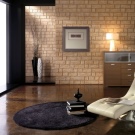




The clinker practically does not load the foundation, and from this it follows that the building, in the decoration of which this building material was used, will not collapse from the additional load during operation. Some restorers specifically use clinker tiles for cladding dilapidated houses.
An amazing feature of clinker is the ability of the product to strengthen and stabilize during operation, in other words, in 50-60 years the building material will be stronger and stronger.
As noted earlier, both brick and natural stone can be imitated at the production stage. Thanks to this, you can significantly save on finishing the suburban area.



Moreover, you can save not only money, but also the time that could be spent on this work.
Another plus, of course, is the product's resistance to mold, fungi, ultraviolet light, microorganisms, pests and fire. Possesses material and good thermal insulation, sound insulation. Special care is not required for it, it is enough to wipe it with a damp cloth from time to time, in advanced cases, use household chemicals.
It is easy to guess that you will have to pay extra for the advantages - this will be the main disadvantage. It should be borne in mind that during installation it is unacceptable to use cheap adhesive mixtures, grouting and mortars. This can negatively affect the service life.



They try to counterfeit any expensive product, and clinker tiles are no exception. Remember, if you use a cheap analogue, then with a high degree of probability it will be unsuitable for outdoor use.
When laying clinker indoors, it should be borne in mind that this material remains cold even in the summer season, so it is necessary to take care of floor heating in advance. A heating system is perfect for this.
Unfortunately, if any tile becomes unusable, it will be difficult to find a similar one in the store, so you always need to buy building materials with a small supply.



Views
According to the production technology, there are extruded tiles and made by pressing. In addition, clinker tiles can be glazed or unglazed. The second option is more common, only clay is used for its manufacture. The building material is obtained in a natural color, which depends only on the type of clay and the combination.
If charcoal is added to the clay at the production stage, then the product turns out to be dark in color, and when coal, clay and sandstone are combined, not only various patterns are obtained, but also rough surfaces.

Natural brightness and color overflow is achieved by varying the heat level. In addition, the color of the product is influenced by its location in the oven. This is what leads to the fact that in one batch there may be material that differs in color.
Glazed tiles, popularly called glazed or smoked tiles, are also produced in one firing. Glaze is applied to the resulting product. It is applied either in one or in two layers, but the glaze should not be thicker than 2-2.5 mm. After firing, the decorative layer is firmly fixed to the base.


Manufacturing plants produce clinker corresponding to five strength classes. For interior decoration of city apartments and country houses, products from 1 to 3 class are bought... The second class is suitable for bedrooms, the third - for children's rooms, offices, bathrooms, hallways and dining rooms.
Clinker tiles of the 4th class of wear resistance are suitable for commercial enterprises... With its help, you can make garden paths on your personal plot. Has increased wear resistance clinker class 5. As a rule, this flooring is found in places with a high customer flow..


In recent years, flexible clinker has been widely used; in stores it is found under the name keralin... This building material can be easily rolled up into a tube and returned to its original state without any consequences.
80-85 percent of keralin consists of kaolin, clay, chamotte and quartz sand, the rest is made up of special components. Thanks to this, the material is not only flexible, but also lightweight. It can be used to veneer both rectangular and arched surfaces.


Has not lost keralin and the qualities inherent in clinker tiles - frost resistance, moisture resistance, wear resistance, environmental safety. Keralin can be used to decorate walls, ceilings, facades, terraces and garden paths.
Dispersed acrylic acts as an adhesive base, which is not subject to fire, does not emit harmful odors and substances, and is moisture resistant. It perfectly imitates brickwork, making it suitable for cladding fireplaces and stoves.
Drainage and lawn clinker, produced in the form of a lattice, can be used as a design object. The lawn grows well through such a grid, while the clinker can easily support the weight of the car, thanks to which the damage to the soil is minimal.

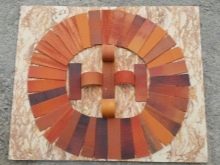

Dimensions (edit)
European manufacturers produce clinker with a thickness of 10 to 17 mm. The length is usually 240 or 300 mm. But these indicators are conditional, often factories themselves select the sizes for their products. For example, small-sized clinker tiles used as paving stones have dimensions of 100x200 mm. Its thickness is most often 50 mm. And to imitate a tile, a product with dimensions of 300x300 mm is produced.
Flexible clinker tiles have a weight of 4-6.4 kg per 1 m2 with a thickness of 4 mm and more, due to which they practically do not affect the ceilings, walls and foundations. Since certain dimensions are not fixed, any buyer can order the product according to his size.


Domestic manufacturers, although they use foreign equipment, are trying to produce building materials according to TU.
Most often, clinker made in the countries of the former Soviet Union and used for facade cladding corresponds to the following dimensions: 450 mm in width, 150 mm in length and 9 mm in thickness.


Colors and designs
As noted earlier, the color of the clinker depends on the color of the clay and on the temperature at which it was fired. Most often, red and brown clinker tiles come off the conveyor. Green clay contributes to the creation of a red hue. White and black coloration are very rare.
By adding coloring pigments, the color of the product can be influenced. Due to this, there are yellow, beige (including ivory) on sale. Smooth glazed tiles can have an additional color scheme on the outside, including with a specific pattern.



In addition, imitation tiles are made for wood and stone. It is used for both interior and exterior decoration. Keep in mind that semi-antique building materials are perfect not only for classical, but also for modern stylistic trends.
By the way, dark tiles imitating brick can be used in rooms furnished in industrial, gothic and vintage styles.



Manufacturers and reviews
Customers note that products from countries such as Spain, Italy and Germany are of good quality.
German manufacturer Stroeher is the undisputed leader. In his collection there are several dozen different pieces, including convex, rectangular tiles, as well as Florentine clinker and a special version with notches.
Products manufactured by this company are of high quality, perfectly imitate natural stone. This is achieved through modern digital printing. On sale there are specimens of various colors, including brown and dark gray.



It's no secret that it is easy to slip and injure on a glazed surface. Considering the winters in most of the Russian Federation, the engineers of this company have come up with a special coating. Anti-slip clinker tiles can be used for finishing garden paths, stairs, steps.
Unglazed items from this company are sold at low cost and come in a variety of shapes and textures. Basically, the clinker on sale is found in a dark brown and sandy shade.
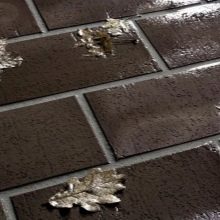


Spanish company Exagres manufactures its products from calcined clay, some models use white clay. Spain, when exporting its goods to the countries of the former Soviet Union, takes into account the local climate, therefore the clinker has an anti-slip surface. Products are sold at affordable prices, while the quality does not suffer.
The “Italica” series has been specially developed for interior decoration. This clinker tile perfectly imitates natural stone. Thanks to the rough surface, the risk of injury is reduced to zero. For pools and bathrooms, a special collection "Taiga" has been invented; when finishing with this building material, it is almost impossible to distinguish natural wood from its analogue. Photo printing with the texture of birch, cherry or coniferous wood is suitable for facing stairs in a country cottage. In addition, such a finishing material does not require any maintenance.


Italy in the ranking is represented by the company Klinker sire... Its range includes products suitable for both luxurious interiors and classic styles. High quality building material, characterized by ease of installation.
This company has been operating in the finishing materials market for several decades. During this time, its products, not in words, but in deeds, have confirmed their resistance to ultraviolet radiation, frost and abrasion.


Another representative of Germany is the company FerdhausKlinker... It has been known all over the world since the middle of the nineteenth century. It is rightfully one of the leaders in the European market. Only local clay is used in the production, this allows us to guarantee the quality of the products.
Complies with German quality standards and products from the company ABC... Unglazed, smooth and structural clinker tiles are produced from its conveyor. There are over 45 colors in the collection.
From a German manufacturer Roben there are ten factories in different countries of the world, thanks to which it becomes possible to significantly save on logistics. This competitive advantage allows Roben to offer its products at a low price, and they, by the way, are presented in a large assortment in building stores.
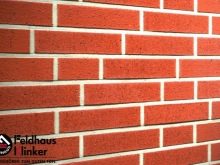


Polish manufacturer Opoczno fell in love with the domestic consumer for clinker tiles of standard sizes 300x300 mm, which can be used as a replacement for expensive porcelain stoneware. It has an excellent value for money.
Company Cerrad from Poland offers clinker tiles for a concrete base, wood, stone, brick. The production uses only environmentally friendly raw materials. The products are frost-resistant, wear-resistant. The anti-slip surface allows you to finish staircases of buildings and cottages with this material.


Due to its fire and biological corrosion resistance, Cerrad clinker can also be clad indoors.
China is represented in hardware stores by firms China Klinker, RSJ-Ceramics, Red Lion and King Klinker... Their products are sold at the same price as the products of the previously described companies, but it's too early to talk about quality, since these manufacturers have just appeared.
But I would like to note that the only manufacturer who managed to win the trust of not only Asian, but also European consumers in a short time is Houson tiles.


The production of clinker tiles has also been established in the Russian Federation. One of the leaders of the domestic segment is the group of companies "LSR"... This is a high quality product sold at a reasonable price. The manufacturer pays special attention to the decor. Not the last place in the ranking is occupied by products from the company "Carolight" and from the enterprise Eco Clinker.


How to choose?
You should know that clinker tiles are suitable for both outdoor and indoor use. It can differ only in color, size and price. It should not contain cement or polymer concrete. A durable product is obtained only from clay.
Since the color of the building material may vary, it is important to buy clinker from one pallet. Otherwise, you will have to spend time sorting.
A little advice: if you mix products from different boxes before installing the clinker tiles, you will end up with an average color.
Sales consultants often advise buying clinker tiles with the so-called "dovetail" - this is a building material that has good adhesion properties and is suitable for cladding industrial premises.

Therefore, it is inappropriate to overpay; ordinary clinker is sufficient for domestic needs.
Some designers advise buying tiles of different colors, but from the same model range. Thanks to this, you can "beat" the room or the facade of the building. To do this, it is enough to buy several boxes of tiles of a different color for the main shade.
German clinker companies guarantee that the service life of their products is 25-30 years, including in the cold, which means that the building material is suitable for finishing a terrace or balcony. But it is very important to examine the packaging before buying. Keep in mind that some manufacturing plants produce double tiles, which must be disconnected before laying. To do this, it is necessary to break the product along the seam.


It is not worth buying material "end-to-end", several boxes of clinker tiles should always be kept in reserve. Unexpected breakdowns may occur at the time of laying or cutting. Do not forget that you will also need a corner tile.
It is important to take into account that clinker with kapinos is used for finishing stairways.... This significantly reduces installation time, as there will be less trimming, adjusting and decorating. This tile can also be used for door sills.
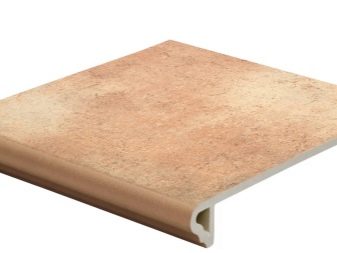

Interior tiles look great both in an apartment and in commercial premises. Thanks to the design and zoning, you can make a resting place for the whole family out of a familiar living room by organizing an additional children's, work and sleeping area. First of all, this should be taken into account by those people who have an apartment or house of small dimensions.
Clinker tiles imitating wood are suitable for finishing baths, swimming pools, saunas... Since all clinker is moisture resistant, special attention must be paid to the color and texture of the building material.
When buying, you should not start from the cost, since there are a large number of fakes in the markets. Do not hesitate to ask for documents guaranteeing product quality... As noted earlier, German, Polish, Italian and Spanish clinker tiles are of good quality.


Laying steps
Finishers note that the installation of clinker tiles is best done on a clean, leveled, smooth, grease-free surface. It is desirable that the base is either concrete or brick. But first things first:
Markup
Finishing tiles are laid only after marking. Certain difficulties can arise with window openings and door frames. Therefore, you need to mark the base, moving from the door or from the window. Thus, the cut parts will be glued either at the cornice or closer to the base. Do not forget when marking the width of the butt joints, in most cases their width does not exceed 12 mm.
By the way, the seam ensures the smooth removal of moisture from under the material, so that the tiles will not fall off prematurely. In addition, the condensation that appears under the building material can adversely affect the floors of the house, be a favorable environment for the spread of mold and microorganisms.

Surface preparation
If we are talking about interior work, in particular about the wall, it must first be cleaned of the old coating. But before that you need to cover the floor with unnecessary rags, cellophane or old magazines.
Don't forget to protect your furniture and household appliances. Concrete dust can damage the product. If there are free rooms in the room, it is best to transfer the interior items to these rooms.


It is highly undesirable to carry out construction work without protective equipment. Garden gloves, gauze bandages, special clothing are suitable for this.
The easiest way to remove wallpaper is with a spatula. Bringing the spatula to the joint and slightly prying the wallpaper strip, dismantling is performed. If the wallpaper does not leave the wall, it is recommended to moisten it abundantly with water.
Old paint is removed in a similar way. By the way, if water-based paint is applied to the wall, the surface must first be sprayed with a spray bottle.
Tile and ceramic tiles, lining and plastic panels are the most difficult to dismantle.... For these purposes, a special tool is used, including a hammer drill and a screwdriver. While maintaining the integrity of the building material, it can be reused.


After that, the surface is checked for evenness with a building level. For household needs, it is enough to use a level with an ampoule, while all three ampoules should be located clearly in the center, otherwise the base will have to be aligned.
Leveling is done using putty... It is applied to the wall with a spatula, the layer should not be thick, the excess must be removed. After the surface has dried, the work is checked by the level... If the result is positive, proceed to the next step.


The next stage involves priming the base. The primer strengthens the walls, in addition, its adhesive properties are enhanced. An acrylic primer copes with the task perfectly. Ideally, the wall should not have traces of dust, grease, old coatings. The front part of the building is also primed and putty. Then the clinker tiles are easily mounted on the prepared base.
If it is necessary to lay clinker tiles on the floor, then the preparation process is not much different from that described above. It is highly likely that small cracks in the concrete base will need to be expanded with a drill.


Before making garden paths from clinker tiles, you will need to prepare the base. For this, a site is marked out, after which about 20 cm of soil is removed... A layer of rubble is poured into the resulting trench and waterproofing is laid. Agrofibre, covering material or geotextile can act as a waterproofing.
Since the installation of clinker is recommended on a concrete base, a cement-sand mixture is to be poured. It is preliminarily thoroughly mixed in a concrete mixer.
Keep in mind that usually concrete dries from 7 to 30 days, all this time you need to monitor the surface, do not allow it to dry out and crack.


Mounting
Since in recent years, thermal panels have been used for facing facades - this is a building material, the basis of which is presented in the form of expanded polystyrene or polyurethane foam, and clinker tiles are fixed on top, this part will not be described within this section.
Most attention will be paid to interior decoration. Please be aware that the process of laying clinker outside when creating stairs or garden paths will not have any special differences, so you can safely duplicate all stages of work.
Installation in the room starts from the corner, for this, first of all, corner tiles are glued to the wall. Thanks to this, there will be no special difficulties with the corners. When facing a fireplace, you should also start from the corner.


If there are no corners, then they start laying from the bottom, gradually going up. Installation is carried out using special crosses that provide the same distance between the tiles. 2-3 pieces are enough for one product.
Some experts recommend starting from the second row if, after carrying out the work, it is planned to "fit" the floor elements. Thanks to this, existing defects can be hidden. Supports can be made of bars, rails or metal profiles.
The special adhesive recommended by the manufacturer is applied to the tiles with a notched trowel. For a wall, the application layer should not exceed 2 mm. For flooring, the thickness can vary from 7-7.5 mm to 15.5 mm. A small amount of glue mixture is applied to the wall or floor, the excess is removed with a spatula and comb.

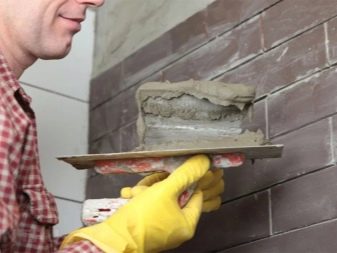
Usually, five kilograms of glue is spent per square meter. It is important to know that different glue is used for interior and exterior work. Installation is carried out only at positive temperatures.
Knead the glue using a construction mixer. If such a tool is not at hand, a perforator with a special nozzle does a good job with this. In principle, manual mixing is also acceptable, but in this case you need to watch out for lumps. The mass should be homogeneous..
As a rule, the glue dries up in 20 minutes, during which time it is necessary to lay the clinker tiles. Otherwise, the glue will dry out, after which it will have to be kneaded again.


Each layer is checked by the building level, as an alternative, a stretched lace can act. Do not forget to move it after completing the installation of the next row.
You can cut the tiles using an angle grinder, tile cutter. Do not forget about safety precautions. If you use a grinder, you must immediately put a good disc. Cutting is best done either on the street or in the entrance.
Many people, wanting to save money, try to make corners from ordinary clinker tiles, in which case you need to carefully cut the building material at an angle of 45 degrees.


I would also like to note that the clinker can be drilled if desired, a special diamond drill is suitable for this.
Further work with the tiles is carried out only after the glue has completely dried, this may take up to two weeks. Subsequently, the seams are rubbed off from the remnants of the glue; a special brush is used for this procedure.
Depending on the wishes of the owners of the premises, grouting of the joints can be performed using the so-called semi-dry method using a cement mixture or using a grout that is previously diluted in water.


In order to check the readiness of the grout, it is enough to squeeze it in your hand. At the same time, it should not spread or crumble; ideally, the mixture should resemble the consistency of wet earth.
The grout is placed on a special rounded spatula, it is brought to the base and with the help of a trowel the seams are “driven in”. The work is carried out at a fast pace, otherwise the grout will become unusable and will not grab. In no case should you save on grouting. The temperature should not be lower than 5-6 degrees Celsius., there should be no moisture on the surface.

In hardware stores, grouting of various colors is found. Thanks to this, you can beat any interior, make the walls homogeneous or, conversely, with pronounced elements.
If a grout for a gun was bought in a building store, then, accordingly, it is necessary to use a special tool. There are no particular differences in application, but usually this grout is more expensive. It is often used to grout thin clinker tiles.
It usually takes up to 5 kilograms of grout per square meter.... It is sold in bags of 25 kilograms. It follows that one bag is enough for grouting five square meters. Since less mix is required for grouting thin tiles, the consumption will be less.

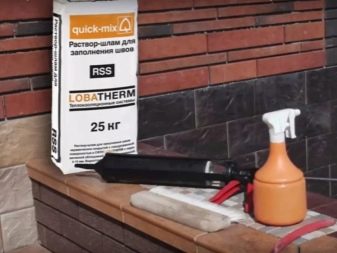
To get rid of the grout residue on the clinker tile surface, you will need a rubber trowel. You will have to tinker a little with the seams that have formed between the windows and the tiles. In this case, experts recommend using a special silicone sealant.
In stores, you can find a special brush for getting rid of excess mixture. If glazed tiles are to be cleaned, then this procedure is best done with a damp cloth to prevent damage to the glossy layer.

It is impossible not to mention the second method of installation, which is called free installation. As a rule, it is used for outdoor decoration, in particular, when creating garden paths. As noted earlier, first a trench is pulled out, waterproofing is laid on its bottom, then 25-50 cm of crushed stone is poured. The surface is leveled using a building rule.
Spacer washers are placed on the leveled surface and clinker tiles are installed directly on them. As in the previously described cladding method, crosses are inserted between the tiles, providing an equal distance.
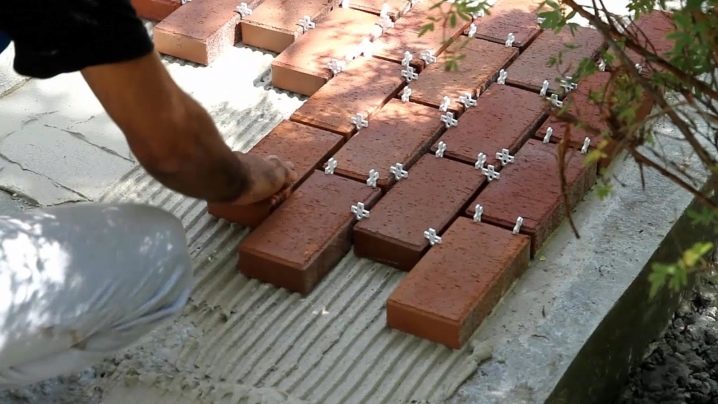
After that, it will remain to close up the joints; for this, a special polish recommended by the manufacturing plants is suitable. In this case, the surface is previously spilled with water. the resulting mixture is poured onto the base. Subsequently, she gradually fills in the voids.
The seams are sealed with a spatula with a rubberized surface, at the same time the base of the clinker tiles is cleaned. Additional cleansing is carried out after the mixture is completely dry. Do not forget to moisturize the surface.... Provided that the installation is carried out in the summer, it is enough to connect the hose to the central water supply and rinse off the remaining glue. Since the clinker has anti-slip properties, the building material can be walked on even after rain.


Examples in the interior
Decorative clinker is used for room zoning. Thanks to this technique, you can decorate the protruding parts of the chimney, ventilation shafts.

When using clinker with kapinos, it is possible to clad ledges, stairs and the lower part of the fireplace. Since clinker tiles are fire resistant, the likelihood of a fire is reduced to zero.

Clinker tiles are suitable as a finishing material for rooms with high humidity. Due to the fact that this building material is easy to clean, it is also used in kitchens. Drops of fat from the working surface can be removed not only with a damp cloth, but also with the use of strong household chemicals.

Flexible clinker tiles can be applied to both rectangular and arched surfaces. The building material bends easily and takes any shape. At the same time, flexible clinker weighs several times less than its main competitor.

In order to drill the clinker tiles, a special diamond drill is used. Then you can hang the shelf or lamps on the clinker. Keep in mind that even if scratches appear on the product, they will hardly be noticeable due to the nature of the product.

The clinker is suitable for many stylistic directions. It is used to equip rooms made in vintage, gothic, loft and industrial styles.
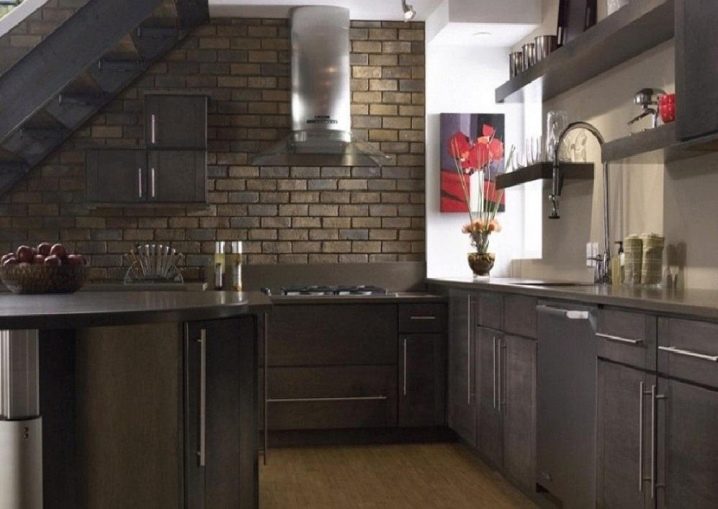
You will learn more about how to mount clinker tiles on the facade.













The comment was sent successfully.